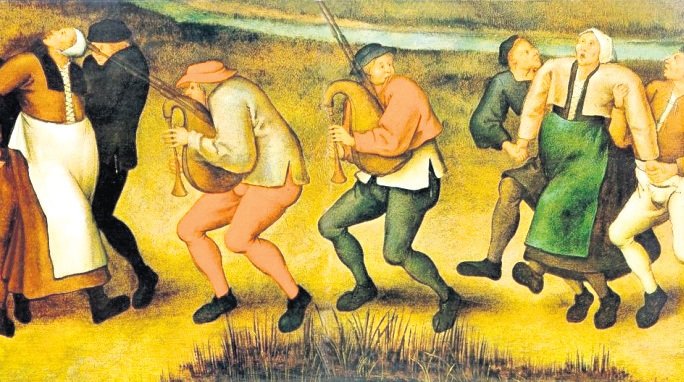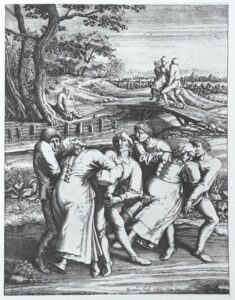
When we think of dance, we think about freedom. The freedom to move, shake and twirl! But what would happen if dancing turned deadly? Imagine a hypnotised person with eyes rolled up, and dancing with a type of dedicated passion that never seemed to waver. Imagine that person dancing not just for minutes or hours but for weeks without any interest in food, water or rest and with a complete oblivion towards concerned onlookers and crowds. And now imagine lots of people doing this. So manic and engrossed in their activity that they couldn’t be bothered with anything else. Dancing and dancing until their bodies forfeited to exhaustion and they collapsed with muscles completely drained as a result of their rhythmic pursuits. The participants, seemingly under some type of spell or trance, couldn’t help themselves.
This is precisely what happened in Strasbourg of the Holy Roman Empire (present day France) in 1518. On 14th July of the same year, a woman named Frau Troffea took to the streets of Strasbourg and began dancing. To most, it seemed ordinary at first. Perhaps she was celebrating a stroke of good luck or perhaps she was escaping the trials and tribulations of being a peasant woman. However, the bizarreness of this incident only seemed to heighten as she went on this hysterical way for 4-6 days. And within a week 30 more people had joined. But this was not a celebratory dancing as the participants would dance till they dropped from exhaustion or even sometimes dead. By August, the epidemic had claimed about 400 victims. It had left the city scared. As city authorities were alarmed by the increasing numbers, they consulted local doctors who in keeping with standard medical wisdom, declared the dancing to be the result of overheated blood. This went on for about 2 months before ending as mysteriously as it began.
BACKDROP
Although we can’t know specifically about the life of Frau Troffea or others, the conditions around were enough to tell the context of their life. People often remember the age of renaissance as one of beauty and progress and a reemergence after the dark middle ages but this is a highly exaggerated generalisation. While it was the birth of artists like Michaelangelo and the printing press (which made ideas circulate fast and easy), the life of the common man wasn’t as luxurious as the footprints of renaissance might suggest. Strasbourg functioned on an agrarian economy. The wellbeing of its citizens depended on the climate, harvest yields and the generosity of a corrupt clergy. In the 30 years leading to the dance plague, the priests had rendered the citizens helpless as they used their power to hoard food and supplies during the harshest drought and lived a life of plentitude, keeping concubines and taxing the poorest citizens with promises that such fees would fastrack their way to heaven. The Holy Roman Empire was on the brink of facing a peasant rebellion. There were many failed attempts of rebellion or protests against the clergy as they were after all the “closest the god”.

Strasbourg was on the river Rhine. Much of its economy functioned around wine production and the majority of its citizens were involved in this. A bad harvest of vineyards and the misgovernance of the clergy meant doom. With constant epidemics, famines and other confrontations with death, they could only attribute this to something divine. Tensions were high. The particularly hot summer of 1516 produced almost negligent crop yield. 1517 was no better. In that spring, an unexpected cold froze the vineyards. Soon after, a violent hailstorm demolished the already poor crops. The people of Strasbourg thought for good reason that St. Vitus was coming with a vendetta.
SCIENTIFIC EXPLANATION
Such beliefs in the supernatural agency can have a drastic effect on human behaviour. A US anthropologist writes about how being raised in an “environment of belief”, wherein spirit possession is believed to be true, primes people to enter a dissociative mental state and normal consciousness is halted. People then behave in the culturally described way of how the possessed should behave.
This can easily apply to what happened in Strasbourg in 1518. The curse of St Vitus is just the kind of supernaturalist belief that can drive the vulnerable into dissociative states. The chronicles agree that most people were quick to assume that an enraged St Vitus had caused the affliction. So all it took was for a few of the devout and emotionally frail to believe that the Saint had them in his sights for them to enter a trance-like state wherein they were compelled to dance for days. If the dancing mania really was a case of mass psychogenic illness, we can also see why it engulfed so many people: few acts could have been more conducive to triggering an all-out psychic epidemic than the councillor’s decision to corral the dancers into the most public parts of the city. Their visibility ensured that other cityfolk were rendered susceptible as their minds dwelt on their own sins and the possibility that they might be next. This deadly epidemic is a testament to how cultural contexts shape how psychological suffering is expressed. What is strange is that while living conditions did improve in Strasbourg eventually, there were other parts of Europe and the world where situations were or even before that have been much worse than what was in Strasbourg. But the dancing plague of 1518 is the last of its kind to be ever recorded.
Could it have been a religious cult? Could it have been a way of protest? Could it have been a stage modelled act to express anger toward the corrupt clergy? Perhaps owing it to a “mass hysteria” is only an assumption with the limited information we have; perhaps we will never know.
As we look around today, mankind’s suffering has only increased. Considering the events that lead up to the dancing plague, aren’t political instability, isolation and the ever increasing hustle to find prosperity and peace added with the tensions of a pandemic enough to induce another mass hysteria or another dancing plague?
By Anezka Saraogi , Kolkata, India


